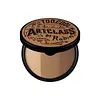What's inside
What's inside
 Key Ingredients
Key Ingredients

 Benefits
Benefits

 Concerns
Concerns

No concerns
 Ingredients Side-by-side
Ingredients Side-by-side

Talc
AbrasiveMica
Cosmetic ColorantPentaerythrityl Tetraethylhexanoate
EmollientMagnesium Stearate
Cosmetic ColorantNylon-12
Titanium Dioxide
Cosmetic ColorantDiisostearyl Malate
EmollientCI 77492
Cosmetic ColorantCI 77491
Cosmetic ColorantAminopropyl Dimethicone
Polymethylsilsesquioxane
CI 77499
Cosmetic ColorantMethylparaben
PreservativeAlumina
AbrasivePropylparaben
PreservativeCeria/Silica Talc
UV AbsorberSilica
AbrasiveWater
Skin ConditioningCyclopentasiloxane
EmollientTitanium Dioxide
Cosmetic ColorantSynthetic Fluorphlogopite
Cetyl Ethylhexanoate
EmollientGlycerin
HumectantTrimethylsiloxysilicate
EmollientLauryl PEG-10 Tris(Trimethylsiloxy)Silylethyl Dimethicone
EmulsifyingButylene Glycol
HumectantNiacinamide
SmoothingDiisostearyl Malate
EmollientMethyl Trimethicone
Skin ConditioningPentylene Glycol
Skin ConditioningPolypropylsilsesquioxane
PEG-10 Dimethicone
Skin ConditioningDisteardimonium Hectorite
StabilisingMagnesium Sulfate
Phenoxyethanol
PreservativeTriethoxycaprylylsilane
Nylon-12
C30-45 Alkyldimethylsilyl Polypropylsilsesquioxane
Aluminum Hydroxide
EmollientCetearyl Dimethicone/Vinyl Dimethicone Crosspolymer
EmollientCentella Asiatica Leaf Water
Skin ConditioningEthylhexylglycerin
Skin ConditioningDisodium EDTA
Tocopherol
AntioxidantCaffeine
Skin ConditioningCamellia Sinensis Leaf Extract
Antimicrobial1,2-Hexanediol
Skin ConditioningCopper Tripeptide-1
Skin ConditioningWater, Cyclopentasiloxane, Titanium Dioxide, Synthetic Fluorphlogopite, Cetyl Ethylhexanoate, Glycerin, Trimethylsiloxysilicate, Lauryl PEG-10 Tris(Trimethylsiloxy)Silylethyl Dimethicone, Butylene Glycol, Niacinamide, Diisostearyl Malate, Methyl Trimethicone, Pentylene Glycol, Polypropylsilsesquioxane, PEG-10 Dimethicone, Disteardimonium Hectorite, Magnesium Sulfate, Phenoxyethanol, Triethoxycaprylylsilane, Nylon-12, C30-45 Alkyldimethylsilyl Polypropylsilsesquioxane, Aluminum Hydroxide, Cetearyl Dimethicone/Vinyl Dimethicone Crosspolymer, Centella Asiatica Leaf Water, Ethylhexylglycerin, Disodium EDTA, Tocopherol, Caffeine, Camellia Sinensis Leaf Extract, 1,2-Hexanediol, Copper Tripeptide-1
 Reviews
Reviews

Ingredients Explained
These ingredients are found in both products.
Ingredients higher up in an ingredient list are typically present in a larger amount.
Diisostearyl Malate is an emollient and most often used in lip products. It comes from isostearyl alcohol, a fatty acid, and malic acid, an AHA.
As an emollient, Diisostearyl Malate helps create a thin film on your skin to trap moisture in. This helps keep your skin soft and smooth.
Nylon-12 is a polymer. It is derived from 12-aminododecanoic acid, an omega-amino fatty acid
According to a manufacturer, it is a talc substitute. Like talc, nylon-12 gives products a satin feel. The manufacturer also claims this ingredients does not block pores and has moderate oil absorption.
This ingredient may not be reef-safe.
Learn more about Nylon-12Titanium dioxide is a mineral UV filter widely used in sunscreens and cosmetics.
It is one of only two UV filters officially classified as “mineral” by regulatory agencies, the other being zinc oxide.
Titanium dioxide provides broad-spectrum protection mostly in the UVB and UVAII range, with some protection in the UVAI range.
While its UVA protection isn’t as strong as zinc oxide’s, the difference is minor.
A common myth is that mineral UV filters reflect UV light. However, modern research shows titanium dioxide absorbs UV radiation like chemical filters (~95% absorption & 5% reflection).
Thanks to its non-irritating nature, titanium dioxide is suitable for sensitive, acne-prone, or redness-prone skin. It is unlikely to cause "eye sting" like other sunscreen ingredients.
A major drawback of this ingredient is its white cast and thick texture. This is why mineral sunscreens often leave a white cast and are less cosmetically elegant than chemical/hybrid sunscreens.
To improve white cast and spreadability, micronized or nano-sized titanium dioxide is often used.
There are ongoing concerns surrounding nano-titanium oxide's impact on marine ecosystems.
There is no conclusive evidence that any form of titanium oxide (or any other sunscreen ingredients) will cause harm to marine ecosystems or coral reefs. The science is still developing but many consumers are keeping a close eye on this issue.
Please note, many destinations have reef-safety sunscreen rules. For instance, the U.S. Virgin Islands advises all visitors to use non-nano mineral sunscreens.
Nano mineral sunscreens once raised safety concerns about absorption into skin.
Extensive research has shown that they do not penetrate healthy or damaged skin; they remain safely on the surface and the top layer of dead skin (stratum corneum).
You'll likely find titanium dioxide bundled with alumina, silica, or dimethicone. These ingredients help make titanium dioxide highly photostable; this prevents it from interacting with other formula components under UV light.
Learn more about Titanium Dioxide